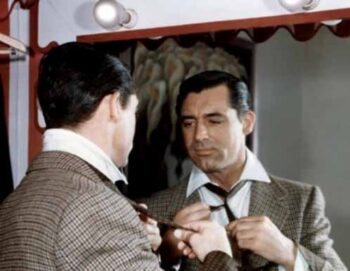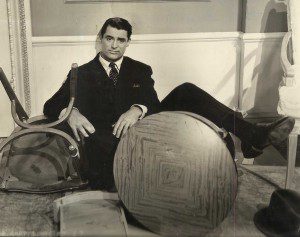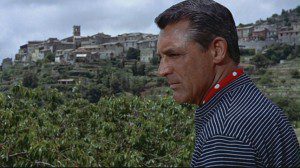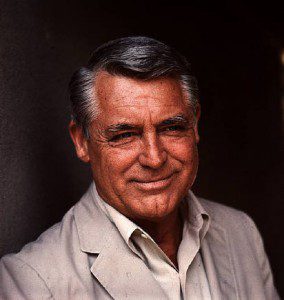
“If you’re waiting for the big finale, I’m sorry. This is all I do.”
–Cary Grant, Father Goose, 1964
Late one day, when Cary Grant was 9 years old, he came home to find his mother gone. She’d been there in the morning, and then when he came home from school, she wasn’t. Grant—or Archie Leach, as he was then known—was first told that she’d gone on a trip, then that she’d died (in fact, she’d been committed to a mental institution). He left his Bristol, England home and went to Southampton, where his father had moved after divorcing Archie’s mother, and asked to be taken in. But the elder Leach was remarried and had a baby, and he told Archie there was no room in his new home. Archie stuck around town, found odd jobs and slept in flophouses. When he didn’t have enough money for a bunk, he’d sleep outside, in alleys or parks. Maybe Archie was hoping his father would reconsider, but he never did. After a year, Archie moved back to Bristol, where he lived with aunts and uncles and cousins, and sat in his room alone at night, holding a picture of his mother, crying.
Archie had learned the defining lesson of his life: he was not wanted. He was on the outside. To be accepted, to be relevant, he would need to become someone else. He would spend the next half-century creating that person and then, at age 60, decide that it was time to reveal his true self, in Father Goose. But it wouldn’t be as easy as that.
***
Cary Grant has been called the perfect movie star. It seems like a simple enough phrase, but the more you think about it, the more it means. It means that no one more fully embodied the glamour and romance of Hollywood movies, especially those from Hollywood’s golden age, which Grant’s career paralleled. It means, too, that no one was more fun to watch. And it means that no one was better at being simultaneously accessible and remote: even while he was our highest aspiration, we knew we could never become anything like him.
But more than anything, it means that no one was better at playing the career management game of movie stardom. The list of characters Cary Grant declined to play is varied (T.E. Lawrence in Lawrence of Arabia; Humbert Humbert in Kubrick’s Lolita; Linus Larrabee in Sabrina; Henry Higgins in My Fair Lady), but they have one thing in common: they’re all outside the well-defined scope of Grant’s familiar screen persona. He may have been capable of playing these roles, but for the sake of his movie stardom, he wasn’t willing.
Because here’s the essential thing about movie stars: they play it safe. They create a persona, and hide in it. Movie stars aren’t like actors; in many ways, the two are opposite. Actors expose themselves; movie stars conceal. An actor has to take chances, use his pains and secrets and imagination, and create something new with every role. But a movie star doesn’t create so much as re-create: once he has the audience’s love, he tries to keep it by doing the same trick again and again, burnishing and refining his performance with each encore. A good actor creates many characters, a good movie star only one.
***
Separated from his real family, Archie found a proxy in the English Music Halls. At first he was a stagehand, then an acrobat, juggler, and mime. A child creates himself by trying out behaviors and reading the response from the world around him. Archie’s world was the audience, and their applause guided him to the person they wanted him to be. When he was 16, his troupe was invited to the U.S. for a visit, and when the tour was over, Archie stayed behind. After all, there was nothing to go back to. He worked in Vaudeville and briefly on the stage, and signed his first contract with Paramount in 1931. The studio chiefs made him choose a new name from a list. He picked Cary Grant because Gary Cooper and Clark Gable had found such success with the initials.
Like most actors of that era, Grant made movies at a breakneck pace, 30 in his first five years, but in none of them do we see the Cary Grant we’ve come to know. He quickly became a star, but only a middle-class star. His name was always on the poster, but never first. People liked him, but he was never the reason they came to the theater. He played detectives and playboys and lawyers and pilots. He played opposite some of the biggest names: Myrna Loy, Mae West, Carole Lombard. But while he showed flashes of what he would become, he never played Cary Grant, the one we know now. Seeing him on those early roles now is like seeing someone you know very well, but with a different haircut and wearing different clothes.
In 1935, Grant was approached at a party by MGM studio head Irving Thalberg. MGM was putting together a production of Mutiny on the Bounty. Charles Laughton and Clark Gable were already cast, and Thalberg wanted Grant to play Roger Byam, a major role. Grant read the book and the screenplay, and he knew that not only were they both exceptional, but that appearing in a film with Gable, the world’s biggest star, could push him to the next level. But when Thalberg approached Paramount head Adolph Zukor about loaning Grant out (a common practice), Zukor said no because he’d had the same realization as Grant: the role would make Grant a top-line star and give him too much bargaining power. With only a year left on Grant’s contract, Zukor thought it was more prudent to continue feeding him mediocre parts in mediocre films, then negotiate a new contract at a lower rate. Grant was forced to watch the role go to Franchot Tone, who won an Oscar for his performance, and he was so incensed that he vowed not only never to sign with Paramount again, but never to sign a long-term contract with anyone ever again. At the height of the studio system, this was considered career suicide, and friends advised strongly against it. But Grant was determined. He didn’t have Zukor looking out for him, and he didn’t have his mother or his father. The only person he had on his side was Cary Grant.
***
To explain Hollywood, Grant liked to describe a scene from Pay Day, by Charlie Chaplin. The Tramp is trying to get the last trolley home, and there’s a huge crowd. He fights his way on, but as the other passengers rush in, he’s pushed right out the other end. This, Grant liked to say, is how Hollywood works:
Actors and actresses are packed in like sardines. When I arrived in Hollywood,Carole Lombard, Gary Cooper, Marlene Dietrich, Warner Baxter, Greta Garbo, Fred Astaire, and others were crammed onto the car. They were the big stars. At the front, new actors and actresses pushed and shoved to get aboard. Some made it and slowly moved toward the center. When a new star came aboard, an old one had to be edged out the rear exit. The crowd was so big you were pushed right off. There was room for only so many and no more.
***
 The Cary Grant we all know began with Jerry Warriner, the character he played in one of his first films as an independent, The Awful Truth (1937). A long description of Warriner is unnecessary; the easiest thing is simply to say that he was quintessential Cary Grant: suave but earnest, beautiful but unpretentious, hilarious but romantic. It was the first character he ever played that we can really recognize as Grant, with all the familiar gestures and rhythms and tics. It was the model for every role Grant would play for the next 27 years.
The Cary Grant we all know began with Jerry Warriner, the character he played in one of his first films as an independent, The Awful Truth (1937). A long description of Warriner is unnecessary; the easiest thing is simply to say that he was quintessential Cary Grant: suave but earnest, beautiful but unpretentious, hilarious but romantic. It was the first character he ever played that we can really recognize as Grant, with all the familiar gestures and rhythms and tics. It was the model for every role Grant would play for the next 27 years.
The Awful Truth, a romantic comedy of the kind Grant seems to have practically invented, couldn’t have been more different from Mutiny on the Bounty, and it did what no other movie could have: it made Grant not just successful, but unique. It allowed him to forge a new kind of screen persona: the light comedian who could be physical and ridiculous without sacrificing his romantic credentials. It made Grant a huge star, but watching him during this period (the late-1930s to the early-1950s), it’s almost as if he doesn’t quite believe it. There’s a restlessness to his performances, an eagerness. It’s the work of an actor who wants desperately to be liked, who’s trying as hard as he can to stay on the trolley. He’ll put on a dress, fall over a chair, slip into a mud puddle, be the butt of the jokes, let himself be beta to the alpha dogs. He redefined what it meant to be a man on screen—he wasn’t tough and he wasn’t trying to woo the girl; he let the girl chase him. Of course, he fell for the girl and he almost always wound up with her, but his first and one true love, no matter what, was that proxy, the audience.
***
Bristol was a working class town, and Grant’s natural accent was Cockney. When he came to the U.S., he tried to lose it, but he never really could. The best he could do was alter it, and his diction—a wrenched, at times slightly pained thing stranded between sophistication and bluntness—became as much a trademark as the dimple in his chin. His accent was one of the reasons he turned down the role of Henry Higgins in My Fair Lady. Who would believe him as a phoneticist? At heart, he told friends, he was more Liza Doolittle than Higgins. Because no matter how fully Archie Leach had become Cary Grant, no matter how much he immersed himself in the persona, he always felt the specter of his past, of who he might have become under other circumstances, hanging over him.
The tension between who Grant thought he really was and who he thought everyone else thought he was, the effort of inventing himself every day, bit by bit, was enormous, and was at least part of what led him to retire briefly in 1953. He’d been in therapy for some time already, and was on his third marriage (there would be five in total). Ex-wives, though many remained friendly with Grant, all told similar stories: they described him as moody and depressive, controlling and given to frequent rages (his first wife, Virginia Cherrill, claimed in divorce proceedings that he hit her). He was also, in his earlier years, known to drink heavily and at least once attempted suicide. All was not well with Grant, and in retiring he announced that he was dedicating his life to traveling, reading, and above all unlocking the mystery of himself.
But his first retirement lasted less than a year. His marriage had begun to fall apart again, but more than that, who was he if he wasn’t Cary Grant? Where could Cary Grant exist but on the screen? He returned in Alfred Hitchcock’s To Catch a Thief, but he was different. He looks like a man who’s begun to disbelieve everything around him. He seems wary, even slightly annoyed. He can still do it all. He can be Cary Grant in his sleep. He’s still funny, he’s still charming. But there’s a gravity, a reticence. The bug-eyed expression he used so often in his early career is not just gone forever, but replaced by its opposite, a squint. He looks like a man who’s awoken in a strange place and, for all its glamour, begun to doubt its value.
***
 There’s something else about movie stars, something problematic: they’re not allowed to age. Cary Grant created a 33-year-old identity and performed it again and again, but just like everyone else, he was getting older all the while. He spent a lot of the second half of his career trying to figure out who Cary Grant was at 45, 55, 60.
There’s something else about movie stars, something problematic: they’re not allowed to age. Cary Grant created a 33-year-old identity and performed it again and again, but just like everyone else, he was getting older all the while. He spent a lot of the second half of his career trying to figure out who Cary Grant was at 45, 55, 60.
In Father Goose, Grant thought he may have found a way forward. He played Walter Eklund, a slovenly, drunken misanthrope intent on sitting out World War II in the seclusion of a South Seas island. To Grant, it was the perfect role, because it was him, the real him. Or rather, it was the idea he had of himself, because Eklund was the kind of person a Cockney kid from Bristol might grow up to be. After reading the script, he told friends, “I am Walter Eklund.” But playing himself was only half his goal. The other half was winning that ultimate badge of Hollywood club membership, an Academy Award. Because even though Grant was the ultimate product of the Hollywood machine, he was an outsider thanks to the lifelong enmity he earned from the industry when he went independent. In Walter Eklund, he hoped to reveal his true self and win true acceptance all at once.
But it’s a funny thing about playing a part: if you do it long enough, eventually you can’t stop. Grant may have wanted to use Eklund as a way back to himself, but when he got there Eklund looked an awful lot like Cary Grant. There was no gruff, lower-class self hiding in there, at least not one he could put on the screen. There was a rich, tanned movie star, who could grow a beard and scowl, but remained essentially the same.
In the film, Eklund has barely arrived, grudgingly, on the island where he’s been rooked into acting as a plane spotter, when he gets stuck with Catherine Freneau (Leslie Caron), a French nanny, and seven young schoolgirls. The proper Freneau and the disheveled Eklund fight like cats and dogs and, naturally, get married in the end. In other words, it’s the plot of a perfect Cary Grant movie. Although Grant was reportedly embarrassed by the age difference between him and Audrey Hepburn in his previous film, Charade (they were 59 and 34, respectively), here the gap has only widened: Grant’s 60 to Caron’s 33. And for all his superficial unfriendliness, his wrinkled khakis, and his stubble, Walter Eklund charms Caron, gets the laughs, let’s the girl catch him, and wins the audience.
Father Goose was released late in 1964, perfectly timed for awards season. Grant, who normally did a minimum of press, made himself unusually available for interviews. He based his Oscar hopes on the Academy’s fondness for actors playing against type, and saw Humphrey Bogart in The African Queen as his model, and indeed the screenplay did win. But seeing Father Goose now, an Oscar for Grant seems far-fetched. It isn’t that the film is bad, but it’s very slight. And above it all, it’s quite typical. Grant imagined it as a radical departure, the moment when, for the first time, he stepped out on the stage not as the audience’s idea of who he should be, but as himself. But when the cameras started to roll, there was no one else to be but Cary Grant.
***
After Father Goose, Grant announced that he would make one more movie, then retire for good. His last was Walk, Don’t Run, and he played Sir William Rutland, a British businessman visiting Tokyo, and about the furthest thing you can imagine from a hard-drinking Cockney grouch.
Over the last several years of his life, he toured the country performing a one-man show, Conversations With Cary  Grant, telling anecdotes about his career. He was retired from the screen, but seemed to have accepted that Cary Grant was the only him he’d ever have. Maybe it was enough, or maybe it was more than enough, as authentic an identity as anyone ever has. In between touring, he spoke with Gene Siskel in one of his last interviews, and he brought up the trolley again. When Siskel pointed out that Grant had earned himself a permanent place, that he’d managed to rise above the usual jockeying for position most stars had to endure, Grant offered his final pronouncement on Hollywood.
Grant, telling anecdotes about his career. He was retired from the screen, but seemed to have accepted that Cary Grant was the only him he’d ever have. Maybe it was enough, or maybe it was more than enough, as authentic an identity as anyone ever has. In between touring, he spoke with Gene Siskel in one of his last interviews, and he brought up the trolley again. When Siskel pointed out that Grant had earned himself a permanent place, that he’d managed to rise above the usual jockeying for position most stars had to endure, Grant offered his final pronouncement on Hollywood.
“I forgot to tell you,” Grant said. “When you get off the trolley, you notice that it`s been doing nothing but going around in circles. It doesn`t go anywhere. You see the same things over and over. So you might as well get off.”




